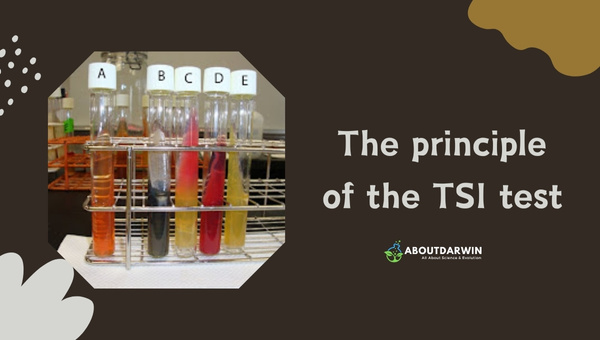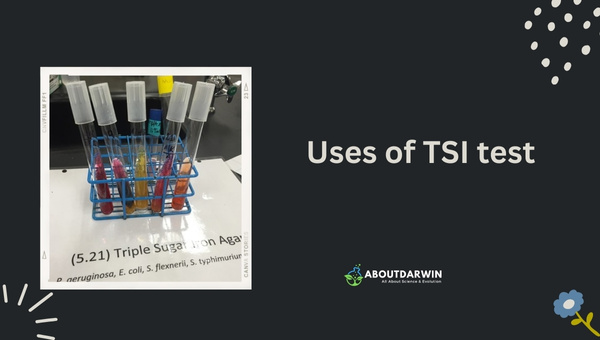Physical Address
304 North Cardinal St.
Dorchester Center, MA 02124
In the intricate world of microbiology, the Triple Sugar Iron (TSI) Test stands out as a pivotal method for identifying bacterial species.
This test not only differentiates microorganisms based on their carbohydrate fermentation abilities but also reveals their metabolic characteristics through observable color changes and gas production.
With its reliable application in clinical laboratories and medical research, the TSI test is essential for diagnosing infections caused by notable bacteria such as Salmonella and Shigella.
As we explore its significance, the fascinating interplay of science and diagnostics unfolds, showcasing the test’s indispensable role in modern microbiology.
Contents
The Triple Sugar Iron (TSI) Test is a crucial microbiological assay used primarily to differentiate among enteric bacteria based on their ability to ferment sugars and produce hydrogen sulfide (H₂S).
This test is particularly significant in clinical microbiology for identifying various gram-negative organisms, especially those belonging to the Enterobacteriaceae family.
The TSI test utilizes a specialized agar medium that contains three sugars—glucose, lactose, and sucrose—along with indicators that facilitate the observation of fermentation and gas production.
Triple Sugar Iron (TSI) is a differential medium used in microbiology to assess the ability of bacteria to ferment specific carbohydrates and produce hydrogen sulfide (H2S).
This test is particularly valuable for identifying members of the Enterobacteriaceae family, which includes significant pathogens like Salmonella and Shigella.
The TSI agar is composed of:
These ingredients are mixed, sterilized, and solidified in a slanted test tube to create both aerobic and anaerobic environments for bacterial growth.
The results are interpreted based on color changes and gas production:
The TSI test is primarily used to:
This test remains a fundamental tool in microbiological diagnostics for its simplicity and effectiveness in identifying specific bacterial species.
The Triple Sugar Iron (TSI) test is a crucial microbiological assay used primarily to differentiate enteric bacteria based on their fermentation capabilities and hydrogen sulfide production.
This test provides insights into the metabolic processes of various gram-negative bacteria, aiding in their identification.

The TSI test utilizes a specially formulated agar medium that contains three sugars—glucose, lactose, and sucrose—along with a pH indicator and compounds for detecting hydrogen sulfide.
The principles behind the TSI test is essential for microbiologists in clinical and research settings.
The TSI test is designed to evaluate a microorganism’s ability to ferment sugars and produce hydrogen sulfide (H₂S). The medium consists of:
When bacteria ferment the sugars present in the medium, they produce acids that lower the pH, resulting in a color change from red to yellow.
The interpretation of results is based on the color changes observed in the slant (aerobic) and butt (anaerobic) portions of the agar:
If H₂S is produced during fermentation, it reacts with ferrous sulfate to form black precipitate (ferrous sulfide), typically observed at the bottom of the tube.
This blackening can occur alongside acid production, complicating interpretation but providing critical information about the organism’s metabolic capabilities.
Some bacteria may also produce gas as a byproduct of fermentation, which can lead to bubbles or cracks in the agar. This gas production further aids in distinguishing between different bacterial species.
The TSI test is a multifaceted tool that not only assesses sugar fermentation but also provides insights into gas and H₂S production, making it invaluable for identifying enteric pathogens like Salmonella and Shigella among others.
Also Read: Acid-Fast Stain Revealed: Unveiling Microbial Secrets
The TSI (Triple Sugar Iron) test is a crucial microbiological tool used to identify and differentiate various bacterial species, particularly within the Enterobacteriaceae family.

This test assesses the ability of bacteria to ferment different sugars and produce hydrogen sulfide, providing insights into their metabolic characteristics.
The results of the TSI test can help in diagnosing infections and understanding bacterial behavior in clinical and research settings.
Interpreting the results of a Triple Sugar Iron (TSI) Test requires keen observation and understanding. Here, I will explain what a positive or negative impact could mean:
| Test Result | Color of Medium | Gas Production | What it Reveals |
|---|---|---|---|
| Positive | Yellow | Present (Yes) | Bacteria present are able to ferment one or all three sugars, resulting in the production of acid and gas. |
| Black (butt only) | Not Required | Bacteria can reduce sulfur to hydrogen sulfide; a Black precipitate is formed. | |
| Negative | Red | Absent (No) | The bacteria cannot metabolize the sugars; the area of growth remains red due to the alkaline condition. |
It’s intriguing how the bacterial behaviors and reactions align with the interpretation markings made on table grounds. This dramatically simplifies understanding the complex scientific process underlying such biological occurrences.
Also Read: Planning a Perfect Family Reunion: A Comprehensive Guide
The Triple Sugar Iron (TSI) test is a crucial microbiological assay utilized primarily to differentiate enteric bacteria based on their ability to ferment carbohydrates and produce hydrogen sulfide.
This test is instrumental in identifying various Gram-negative bacilli, particularly those within the Enterobacteriaceae family, such as Salmonella and Shigella.
The TSI test evaluates the fermentation patterns of three sugars—glucose, lactose, and sucrose—along with the production of hydrogen sulfide, thereby providing insights into the metabolic capabilities of the tested microorganisms.
The Triple Sugar Iron (TSI) Agar Test is a crucial microbiological procedure used to identify and differentiate enteric bacteria based on their ability to ferment carbohydrates and produce hydrogen sulfide (H2S).
This test is particularly important for classifying members of the Enterobacteriaceae family.
Purpose and Principle: The TSI test serves multiple purposes:
Procedure:
Applications: The TSI test is primarily used for:
Limitations: While TSI agar is a valuable diagnostic tool, it has limitations:
Overall, the TSI agar test remains a fundamental method in microbiology for identifying enteric pathogens based on their metabolic characteristics.
The Triple Sugar Iron (TSI) test is a vital microbiological method used to differentiate enteric bacteria based on their carbohydrate fermentation capabilities and hydrogen sulfide (H2S) production.
The results of the TSI test are recorded as the appearance of the slant and the butt of the agar, typically noted as “slant/butt” (e.g., A/A, K/A).
The results from a TSI slant can be interpreted based on color changes and gas production:
| Result | Slant Color | Butt Color | Gas Production | H2S Production | Interpretation |
|---|---|---|---|---|---|
| A/A | Yellow | Yellow | Positive (+) | Negative (-) | Fermentation of glucose, lactose, and/or sucrose; acid produced. |
| K/A | Red | Yellow | Positive (+ or -) | Negative (-) | Fermentation of glucose only; alkaline slant due to peptone utilization. |
| K/K | Red | Red | Negative (-) | Negative (-) | No fermentation; strictly aerobic respiration. |
| A/A; H2S+ | Yellow | Yellow | Positive (+) | Positive (+) | Fermentation of sugars with H2S production (black precipitate). |
| K/A; H2S+ | Red | Yellow | Positive (+ or -) | Positive (+) | Glucose fermentation with H2S production; alkaline slant. |
Pseudomonas aeruginosa exhibits specific characteristics when subjected to the Triple Sugar Iron (TSI) test. Here are the detailed results and interpretations for this bacterium:
Red Slant/Red Butt (K/K):
Gas Production:
Hydrogen Sulfide Production:
Pseudomonas aeruginosa shows a K/K reaction on TSI agar, indicating it does not ferment any sugars and remains alkaline throughout the medium.
This characteristic helps differentiate it from other enteric bacteria that do ferment carbohydrates and produce acid and/or gas. The results are consistent with its metabolic profile as a non-fermenter, utilizing alternative pathways for energy production.
A yellow (acidic) color in the slant and butt indicates that the organism being tested ferments dextrose, lactose, and sucrose.
Carbon dioxide is produced in Tsi.
The slant can become a deeper red-purple (more alkaline) as a result of the production of ammonia from the oxidative deamination of amino acids.
A positive result could signify two things: the presence of gas indicates that the bacteria can ferment one or all three sugars, and black coloration at the butt means that bacteria can reduce sulfur to produce hydrogen sulfide.
Failure to stab the butt invalidates this test. The integrity of the agar must be maintained when penetrating.
The TSI test, or Triple Sugar Iron test, stands out as a fundamental tool in microbiology for identifying and differentiating bacterial species. Its effectiveness lies in its ability to reveal metabolic traits through carbohydrate fermentation and hydrogen sulfide production.
The results, indicated by color changes and gas production, provide crucial insights into the presence of specific bacteria, such as Salmonella and Shigella.
The TSI test enhances diagnostic accuracy in clinical laboratories and supports ongoing research in understanding bacterial behavior and developing targeted treatments.